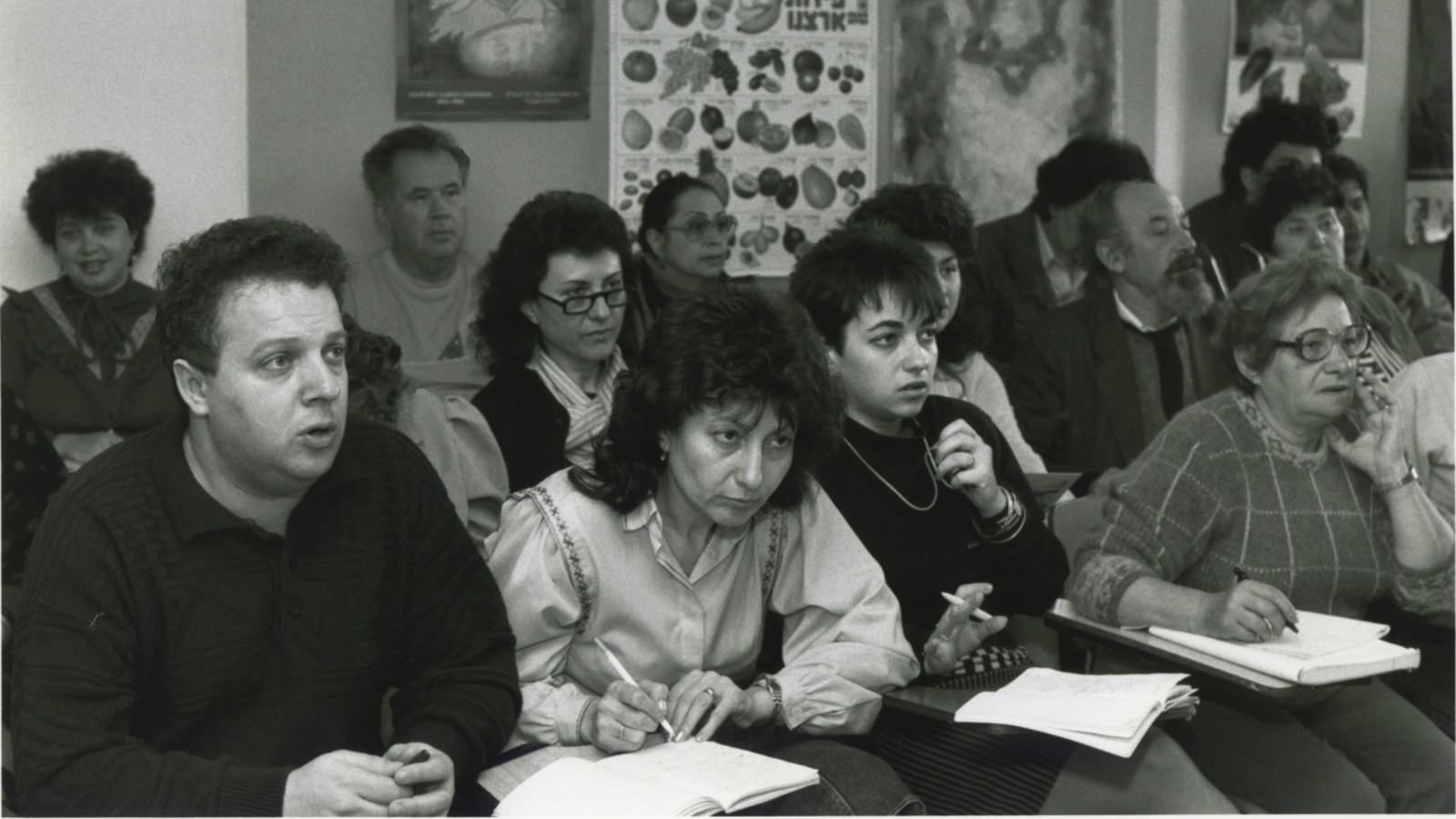AApproximately 350,000 Jewish women moved to Israel from the Former Soviet Union after 1989. Many were highly educated and worked full time, and economic and psychosocial adjustment in the new country was often difficult. Among the key issues they faced were occupational downgrading, sexuality and family life, sexual harassment, marital distress, and single-parent families. Those of partial Jewish or Slavic ancestry also experienced ethno-religious othering and had qualms about undergoing an Orthodox conversion for the sake of their children’s future in Israel. Members of the first generation rarely engaged in political or civic action to change their status, but their daughters have a different take on their rights and entitlements as Israeli citizens.
Occupational Downgrading
Occupational and social downgrading is the most common result of resettlement, especially under conditions of massive immigration like that of the early 1990s. Russian immigrants faced a disparity between their occupational potential and structural opportunities in the Israeli economy. The local white-collar and professional markets were highly saturated and demanded a different set of skills (e.g., computing, Hebrew and English languages, self-marketing) from the ones immigrants had acquired in the FSU. Throughout the 1990s, their unemployment rates were two to three times higher than among men, and they more often had jobs unrelated to their qualifications.
Russian women often had engineering, construction and other Soviet-type heavy industry specialties considered non-feminine or not in demand in Israel. Many had to be retrained for “feminine” occupations (e.g., receptionist, social worker, nursery school teacher), which for women engineers also meant redefining their professional identity. Women with language- and culture-dependent professions in education, medicine, law, and humanities suffered even greater downward mobility. The Israeli academic and cultural market, small and based on a Hebrew-English language mix, was unable to absorb even the established professionals in their field.
Immigrant women in their late forties and older had slim chances of finding any qualified work, even after retraining and despite a state policy of rewarding their potential employers. Many had to live on welfare supplemented by part-time service work (e.g., cleaning or care for the elderly). The latter occupations became a Russian specialty in Israel, since demand is vast and language requirements are minimal.
With your help, My Jewish Learning can provide endless opportunities for learning, connection and discovery.
In sum, female immigrants in Israel faced occupational, economic and social downgrading, typically more dramatic and long-term than their male counterparts of similar age and education. Age serves as the key predictor of occupational success, with the cutoff point being around age forty-five. Younger women with greater cultural flexibility did make their way into the host society, while older women tended to stay in the confines of the ethnic community.
Sexuality and Family Life
Gender roles and family life in the host society are different from those among Russian immigrants. Only about half of Israeli women are employed outside the home, usually as secondary breadwinners.
The average Israeli family has circa three children–almost double the number in Russian immigrant families. Births to unmarried mothers are few. At the same time, secular Israelis are fairly tolerant toward premarital sex and cohabitation of young adults, as long as they are “sexually responsible.” Efficient contraception is widely available and used by the majority of the population. The youngsters have full access to sex information, and the overall climate surrounding sexuality is one of acceptance.
As is often the case with newcomers, their sexual and reproductive conduct, visibly at odds with the mainstream norms, became the focus of public attention. The image of a Russian woman as an attractive but dangerous alien, stressing her sex appeal as a threat to local male mores, emerged as a key element of the Israeli media discourse of the early 1990s. Such attributes of immigrant families as high prevalence of divorce, single motherhood, use of abortion as a birth control method and low number of children became the focus of public debates. Biased imagery in the popular media did a severe disservice to most women with a Russian accent.
Sexual Harassment
During their first years in Israel, women with a Russian accent were often approached with outright sexual offers in the street markets, public parks or buses, in apartments they rented (by the owners), and, of course, in their new workplaces.
Making things worse for the ex-Soviet women, the later Jewish emigration coincided with an influx of illegal sex workers from Russia via international organized crime channels. Post-communist states became one of the major world exporters of sex workers, and Israel proved an easy target due to its unselective immigration policy towards any holder of Jewish documents. Russian, Ukrainian and other Russian-speaking women with false Jewish papers or outdated tourist visas, often traded and detained by force by their owners, filled the massage parlors and nightclubs of Israeli cities.
At the same time, social marginality and the perceived lack of other options may have prompted some younger immigrants to capitalize on their femininity in order to support themselves. Confusion over old versus new sexual norms and the ambient air of sexual freedom among their Israeli peers may have led some women into dress code and behavior interpreted by the locals as “loose” and provocative. Others desperately wanted to join the host society by means of finding an Israeli boyfriend. For some young women, this sexual “vertigo” ended in disillusionment, embarrassment and unwanted pregnancies.
In this manner, downward social mobility was intertwined with sexual disadvantage for female immigrants. Their male counterparts, having similar problems on the labor market, were at least spared sex-related troubles. As studies in other countries show, job loss, lack of promotion and low work satisfaction are not the only costs of sexual harassment in the workplace. Women living under the shade of unwanted sexual advances often experience depression, anxiety, sleep disturbance and sexual dysfunction.
Marital Distress
The studies of resettlement experiences in the U.S., Canada, and other immigration-based countries have shown that uprooted families often suffer marital distress. Downward mobility, the loss or deterioration of informal social networks and inter-generational tension in extended families all contribute to a decline in the quality of marital relations. A similar trend has been shown among Russian immigrants in Israel.
In the Israeli setting, immigrant family stress was heightened by the housing problem: due to soaring rental costs, most extended families had to share small apartments. Forced co-habitation of three generations, reported in one study by over seventy percent of the elderly immigrants, was a constant source of tension, fatigue and lack of privacy for all family members. In these conditions, sexual relations of married couples often suffered irreparable damage.
Other sources of conflict among Russian immigrant couples included low income, employment problems, disagreement about child education in the new culture (e.g., religious vs. secular school) and the varying pace of integration between husbands and wives. The fragility of marriage among former Soviets was augmented by the normative acceptance of divorce as a solution to a deteriorating relationship.
Single-Parent Families
Due to high divorce rates among ex-Soviets (before and after migration), some fifteen percent of all Israeli-Russian families were headed by a single parent (IMIA, 2010). Most of these were mothers with young children, often living together with one or both grandparents—a household type considered an oddity by native Israelis. Since single-parent families are relatively few in Israel (six to eight percent) and single mothers often cannot work full-time, they are viewed as “social cases by default” in need of state support. The mass influx of Russian-speaking single mothers, maladapted to the Israeli job market, without Hebrew skills and with no means of their own, was seen at the outset as a burden to Israeli welfare services (Amir et al., 1997).
Divorce rates in Israel, albeit growing, are still comparatively low. This, along with legal constraints and the economic dependence of women, reflects a strong cultural norm to preserve marital ties at any personal cost, usually paid by the woman (Hartman, 1993). Divorced mothers often felt disapproval on the part of immigration officials, social and welfare workers, their children’s teachers, and other social gatekeepers, including hints that they were a burden on Israeli society. “They see divorce as a woman’s caprice or her inability to adjust to men, to sacrifice her own wishes and ambitions for the sake of family and children,” commented one woman. “They think we are all welfare cases, living at the expense of ‘good taxpayers,’ though this is not true for me and many others. We make our living ourselves like anyone else, and provide for all the needs of our children,” said another single mother (Remennick, 1999).
In this way, cultural differences in marital conduct created a serious locus of tension in immigrant women’s lives. This was especially true when immigrants were aware of being permanently scrutinized and judged by the lay majority and state officials
Summary
Adult ex-Soviet female immigrants of the 1990s (Generation 1) have experienced cumulative adversity of occupational downgrading, responsibility for the young and old in their family “sandwich,” and negative sexual stereotyping by the Israeli mainstream. In addition, those of partial Jewish or Slavic ancestry experienced ethno-religious othering and had qualms about undergoing an Orthodox conversion for the sake of their children’s future in Israel. Only a minority had enough persistence to complete this process, while most have learned to carry their ethno-religious alterity with dignity and/or underplay it in social interactions with Israelis.
Socialized under the Soviet survival code of passive resistance, bypassing barriers and bending the rules, the members of this generation did not engage in political or civic action to collectively change their status as second-class citizens in matters of personal status. Struggling to gain an economic and social foothold in the new society, working long hours in jobs below their skill levels, and taking care of the two generations in their families, these women did not venture out of their private shells to challenge the status quo in the domain of social rights or state-religion relations. Even the more activist of them did not have financial means and cultural tools (Hebrew, local networks) necessary for promoting political agendas.
Their daughters, who were born in the USSR/FSU but came of age in Israel (Generation 1.5) and graduated from local schools and completed military service, have a different take on their rights and entitlements as Israeli citizens. Exposed to the mainstream Hebrew media and surrounded by Israeli-born friends, they have adopted the local codes of civic action and are determined to change the situation for themselves and their children. The most determined of them, like MK Ksenia Svetlova, enter the national legislature and try to change the laws, including those discriminating against non-halakhic Jews and gentiles. Others organize live and internet communities that start an open discussion of all the “dirty secrets” that had been silenced or swept under the rug before—sexual stereotyping and exploitation, ethnic prejudice, glass ceiling at work, etc. The associations of young immigrants headed by women such as Alex Riff and Lena Russovsky organize Russian poetry readings, holiday celebrations, music festivals, and street weddings for the couples who are unmarriageable under religious law in order to make their hybrid cultural identity public and claim its legitimacy in multicultural Israel (Prashizky and Remennick, 2016). Thus, civic media-based activism of these young (mostly female) community leaders employs both political and cultural tools to make its voice heard and broker for social change.
Reprinted from the Shalvi/Hyman Encyclopedia of Jewish Women with permission of the author and the Jewish Women’s Archive.



